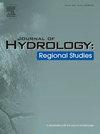Customizing large-scale hydrological models: Harnessing the open data realm for impactful local applications
IF 4.7
2区 地球科学
Q1 WATER RESOURCES
引用次数: 0
Abstract
Study region
Lake Hume in Australia and Harsha Lake in USA.
Study focus
Large-scale hydrological models (LSHMs), though important for both scientific and societal reasons, require the representation of many unknown features that influence river system response. However, current model identification practices in catchment modelling cannot lead to robust LSHMs for local decision-making. To address this, it is necessary to customise the models by integrating local data and knowledge from various sources (e.g. in-situ and earth observations) and fluxes. We present a framework to customize LSHMs for impactful local applications and showcase this using the global WWH hydrological model as the reference LSHM.
New hydrological insights
We present significant improvements in modelling streamflow and actual and potential evapotranspiration, following WWH refinements to include local lakes and reservoir management. Local streamflow measurements and earth observations from NASA MODIS evapotranspiration products were used to re-calibrate the locally adapted model, leading to spatial consistency in performance. Combining multiple variables and metrics during model identification improved streamflow performance and robustness, with combination sets reducing variability and enhancing representation of diverse hydrological processes, highlighting the need for tailored metric and variable selection. This underpins the importance of including informative data in customized multi-objective modelling chains. Finally, incorporating reservoir management improved simulation of a regulated system, with local insights informing reservoir parameterization in LSHMs and bridging the gap to global-scale applications.
求助全文
约1分钟内获得全文
求助全文
来源期刊

Journal of Hydrology-Regional Studies
Earth and Planetary Sciences-Earth and Planetary Sciences (miscellaneous)
CiteScore
6.70
自引率
8.50%
发文量
284
审稿时长
60 days
期刊介绍:
Journal of Hydrology: Regional Studies publishes original research papers enhancing the science of hydrology and aiming at region-specific problems, past and future conditions, analysis, review and solutions. The journal particularly welcomes research papers that deliver new insights into region-specific hydrological processes and responses to changing conditions, as well as contributions that incorporate interdisciplinarity and translational science.
 求助内容:
求助内容: 应助结果提醒方式:
应助结果提醒方式:


